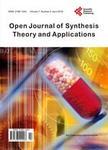Regioselective Synthesis and Biological Evaluation of 1-Hydroxyl Modified Ailanthinone Derivatives as Antimalarials
Regioselective Synthesis and Biological Evaluation of 1-Hydroxyl Modified Ailanthinone Derivatives as Antimalarials作者机构:Division of Experimental Therapeutics Walter Reed Army Institute of Research Silver Spring USA
出 版 物:《Open Journal of Synthesis Theory and Applications》 (合成理论与应用(英文))
年 卷 期:2013年第2卷第4期
页 面:91-96页
主 题:Antimalarials Ailanthinone Triterpenoids Quassinoid Plasmodium Falciparum Multidrug Resistance
摘 要:The triterpene quassinoid ailanthinone is a structurally intricate natural product possessing highly potent antimalarial activity against multidrug resistance plasmodium parasites. Although the mechanism of action of ailanthinone is not completely understood, it is presumed to disrupt regular ribosomal functions by inhibiting parasite protein synthesis. Natural scarcity and low solubility of many quassinoids have impeded their development as potential clinical candidates, but exquisite potency of ailanthinone against Plasmodium remains compelling in the global fight against malaria. Herein, we report the highly selective synthesis of 1-hydroxyl derivatives of ailanthinone, including ester, carbonate, carbamate and sulfonate derivatives. The key feature of the synthesis is a one-step regioselective modification of the 1-hydroxyl group in favor of two other hydroxyl groups at C12 and C13. Derivatives were obtained via direct reaction with acyl/sulfonyl chlorides in the presence of a tertiary amine base without any protection-deprotection. In vitro antimalarial evaluations of these derivatives were compared with chloroquine and mefloquine against the Plasmodium falciparum clones, D6, W2, and TM91C235. The results demonstrate that modification of the 1-hydroxyl group is achievable, and the antimalarial activity of these derivatives relative to the parent product is significantly retained, thus paving the way for synthesis of derivatives with improved biological availability and/or increased potency.



